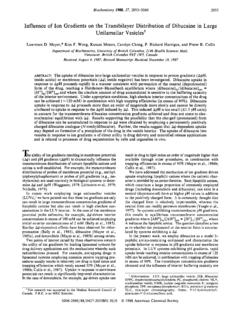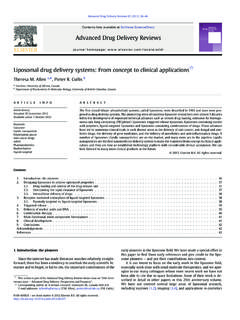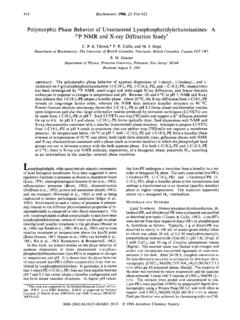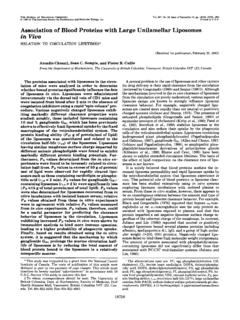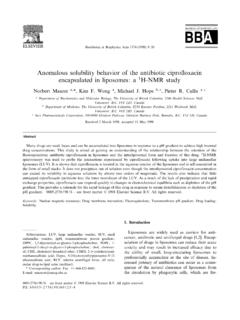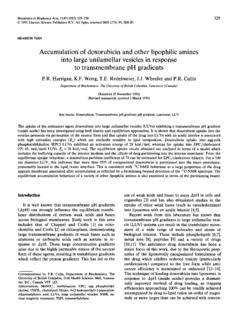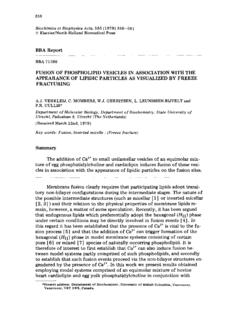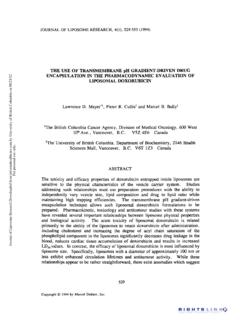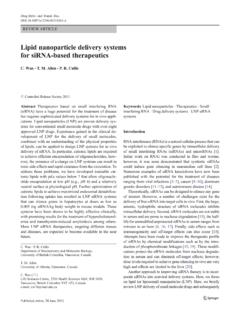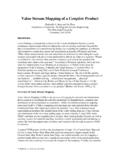Transcription of Bottom-Up Design and Synthesis of Limit Size Lipid ...
1 Article Bottom-Up Design and Synthesis of Limit Size Lipid Nanoparticle Systems with Aqueous and triglyceride Cores using millisecond microfluidic Mixing Igor V. Zhigaltsev,*, Nathan Belliveau, , Ismail Hafez, Alex K. K. Leung, Jens Huft, Carl Hansen, . and Pieter R. Cullis .. Department of Biochemistry and Molecular Biology, Faculty of Medicine, University of British Columbia, BC, Canada . Precision NanoSystems, Vancouver, BC, Canada . Department of Physics and Astronomy, University of British Columbia, BC, Canada ABSTRACT: Limit size systems are defined as the smallest achievable aggregates compatible with the packing of the molecular constituents in a defined and energetically stable structure. Here we report the use of rapid microfluidic mixing for the controlled Synthesis of two types of Limit size Lipid nanoparticle (LNP) systems, having either polar or nonpolar cores.
2 Specifically, Limit size LNP consisting of 1-palmitoyl, 2- oleoyl phosphatidylcholine (POPC), cholesterol and the triglyceride triolein were synthesized by mixing a stream of ethanol containing dissolved Lipid with an aqueous stream, employing a staggered herringbone micromixer. millisecond mixing of aqueous and ethanol streams at high flow rate ratios (FRR) was used to rapidly increase the polarity of the medium, driving Bottom-Up Synthesis of Limit size LNP systems by spontaneous assembly. For POPC/triolein systems the Limit size structures consisted of a hydrophobic core of triolein surrounded by a monolayer of POPC where the diameter could be rationally engineered over the range 20 80 nm by varying the POPC/triolein ratio. In the case of POPC and POPC/cholesterol (55/45; mol/mol) the Limit size systems achieved were bilayer vesicles of approximately 20 and 40 nm diameter, respectively.
3 We further show that doxorubicin, a representative weak base drug, can be efficiently loaded and retained in Limit size POPC LNP, establishing potential utility as drug delivery systems. To our knowledge this is the first report of stable triglyceride emulsions in the 20 50 nm size range, and the first time vesicular systems in the 20 50 nm size range have been generated by a scalable manufacturing method. These results establish microfluidic mixing as a powerful and general approach to access novel LNP systems, with both polar or nonpolar core structures, in the sub-100 nm size range. 1. INTRODUCTION availability of methods, such as extrusion of multilamellar Size matters in drug delivery. For long-circulating drug delivery vesicle (MLV) systems through polycarbonate filters,6 for systems, particle diameter is the most important determinant of making LNP in this size range.
4 Methods for making Limit size biodistribution following intravenous ( ) injection. Long- LNP, which can be substantially smaller than 80 nm, have not circulating Lipid nanoparticles (LNP) of diameter 100 nm or progressed significantly for over 30 years. The most commonly smaller are able to preferentially accumulate at disease sites used method is sonication,7 which is a top down approach such as tumors, and at sites of infection and inflammation, due where micrometer-sized MLV are first formed by dispersion of to their ability to extravasate through the leaky vasculature in Lipid in water, followed by sonication to produce Limit size such Polymer-based nanoparticles (PNP) smaller than systems. For Lipid systems consisting of unsaturated phospha- approximately 50 nm diameter can further permeate through tidylcholine (PC), sonication of preformed MLV results in Limit the lymphatics2 and accumulate in tissues such as bone marrow.
5 Size vesicular LNP with diameters as small as 20 ,9. PNP of 30 nm or smaller can access progressively more tissues However, sonication has many limitations including sample in the body including poorly vascularized ,4 Below contamination, Lipid degradation and, most importantly, lack of approximately 8 nm particles are quickly cleared by the scalability. Other techniques to produce Limit size LNP include Particles in the size range 10 50 nm are therefore the most bottom up approaches whereby LNP are formed by potent in accessing extravascular target tissues and the Synthesis condensation of Lipid from solution rather than by disrupting of such systems is of intense interest for biomedical applications. Received: December 7, 2011. LNP systems used for drug delivery systems have primarily Revised: January 17, 2012.
6 Utilized vesicles of 80 100 nm diameter, largely because of the Published: January 23, 2012. 2012 American Chemical Society 3633 | Langmuir 2012, 28, 3633 3640. Langmuir Article larger structures. Examples include dilution of lipids dissolved ammonium sulfate and doxorubicin hydrochloride were from Sigma- in ethanol by rapid injection of the ethanol solution into a Aldrich Canada Ltd. (Oakville, Ontario, Canada). vigorously stirred aqueous This process can produce Micromixer Design and Fabrication. The micromixer used LNP as small as 25 nm diameter but is difficult to scale and in this study is a chaotic mixer for continuous flow systems with the layout based on patterns of asymmetric grooves on the floor of the suffers from poor reproducibility due to variable injection and channel that induce a repeated sequence of rotational and extensional mixing rates.
7 With regard to nanoemulsions consisting of PC local flows resulting in rapid mixing of the injected streams (staggered and fats such as triglycerides, the production of stable Limit size herringbone micromoxer (SHM)).12 The device was produced by soft systems with size ranges less than 50 nm diameter has proven lithography, the replica molding of microfabricated masters in elusive by any elastomer. The device features a 200 m wide and 79 m high Here we show that rapid microfluidic mixing enables the mixing channel with herringbone structures formed by 31 m high and Bottom-Up Synthesis of well-defined Limit size LNP systems 50 m thick features on the roof of the channel (Figure 1). Fluidic with aqueous and triglyceride cores. By using a staggered connections were made with 1/32 , 3/32 tubing that was herringbone microfluidic mixing device (SHM)12,13 (Figure 1) attached to 21G1 needles for connection with syringes.
8 Syringes of 1, 3, and 5 mL were generally used for inlet streams. A dual syringe pump (KD200, KD Scientific) was used to control the flow rate through the device. LNP Generation. Lipids (POPC or POPC/cholesterol (55/. 45 molar ratio) for preparations of bilayer systems, POPC/triolein at different ratios for preparations of nanoemulsions) were dissolved in ethanol at 10 mg/mL of total Lipid . The LNP were prepared by injecting the ethanol- Lipid solution into the first inlet and an aqueous buffer (saline, 154 mM NaCl) into the second inlet of the micromixer (Figure 1). The appropriate flow rate ratios (FRR, ratio of aqueous stream volumetric flow rate to ethanolic volumetric flow rate) were set by maintaining a constant flow rate in the ethanolic channel and varying the flow rates of the aqueous channel (typically mL/.)
9 Min). Aqueous dispersions of LNP formed this way were collected from the outlet stream resulting from the mixing of two adjacent Figure 1. Schematic of LNP formulation process employing the SHM. streams and dialyzed against 154 mM saline to remove the residual Lipid in ethanol is pumped into one inlet and aqueous buffer into the ethanol. other inlet of the microfluidic mixing device using a syringe pump. Generation of POPC LNP Exhibiting an Ammonium Herringbone structures induce chaotic advection of the laminar Sulfate Gradient. Limit size vesicular POPC LNP containing streams causing rapid mixing of the ethanol and aqueous phases and ammonium sulfate were formed as described above except that saline correspondingly rapid increase in the polarity experienced by the Lipid was replaced with 300 mM ammonium sulfate solution (FRR 3, 10.
10 Solution. At a critical polarity Lipid precipitates form as LNP. mg/mL POPC in ethanolic solution). After formation, the LNP were Dimensions of the mixing channel were 200 m 79 m, and the dialyzed against 300 mM ammonium sulfate to remove ethanol and herringbone structures were 31 m high and 50 m thick. then concentrated to10 mg/mL Lipid with the use of the Amicon Ultra-15 centrifugal filter units (Millipore). An ammonium sulfate we drive LNP formation by millisecond mixing of lipids gradient was generated by exchanging the extravesicular solution with dissolved in ethanol with an aqueous stream. Rapid mixing 154 mM NaCl, pH on Sephadex G-50 spin columns. suppresses mass transport effects that lead to larger and Loading of Doxorubicin into LNP and Doxorubicin heterogeneous Lipid aggregation, enabling the robust Synthesis Assay Protocols.
